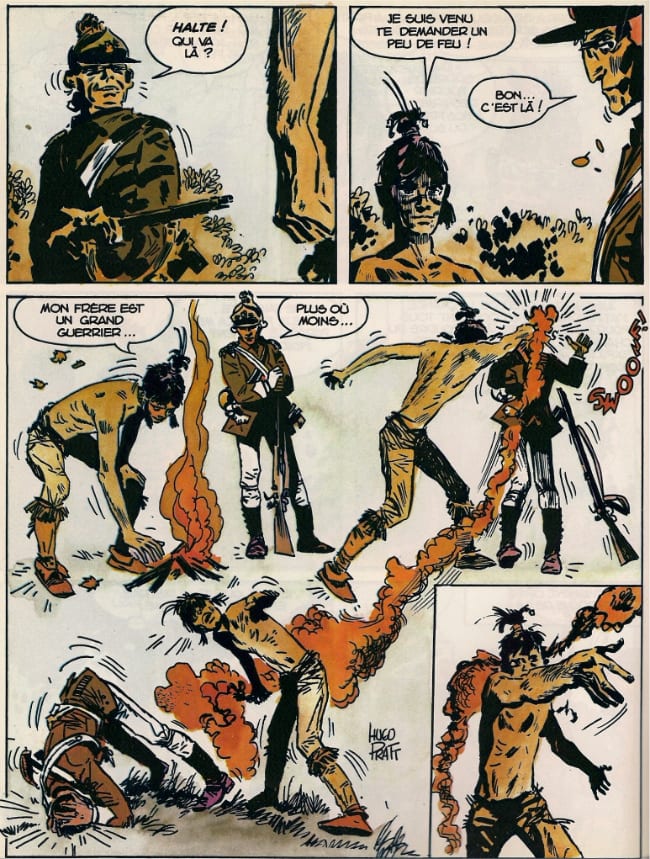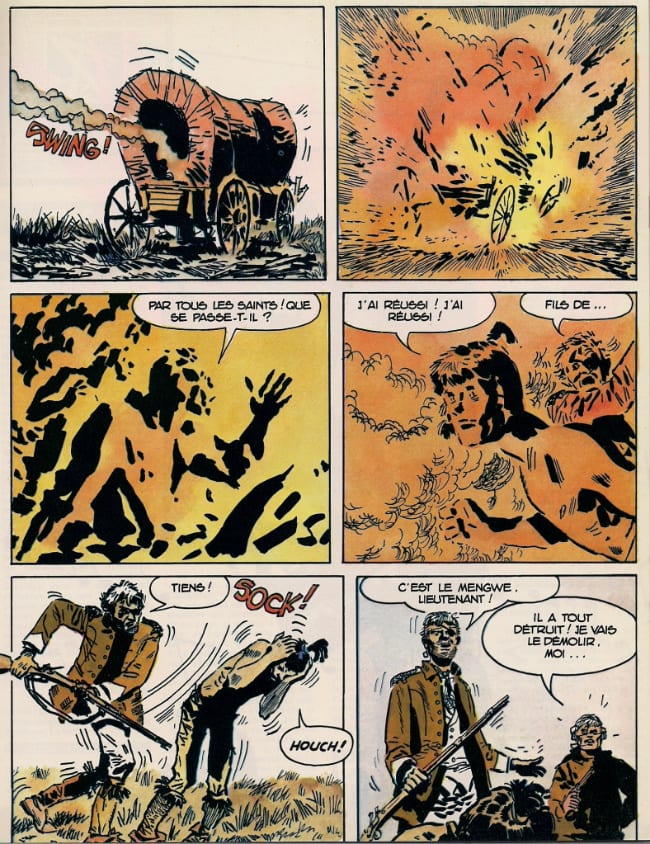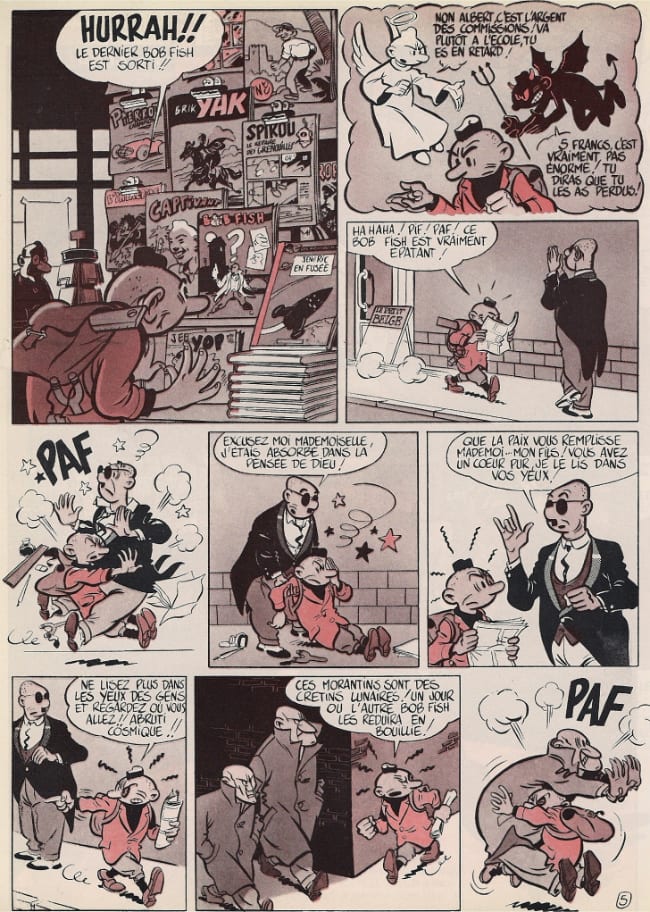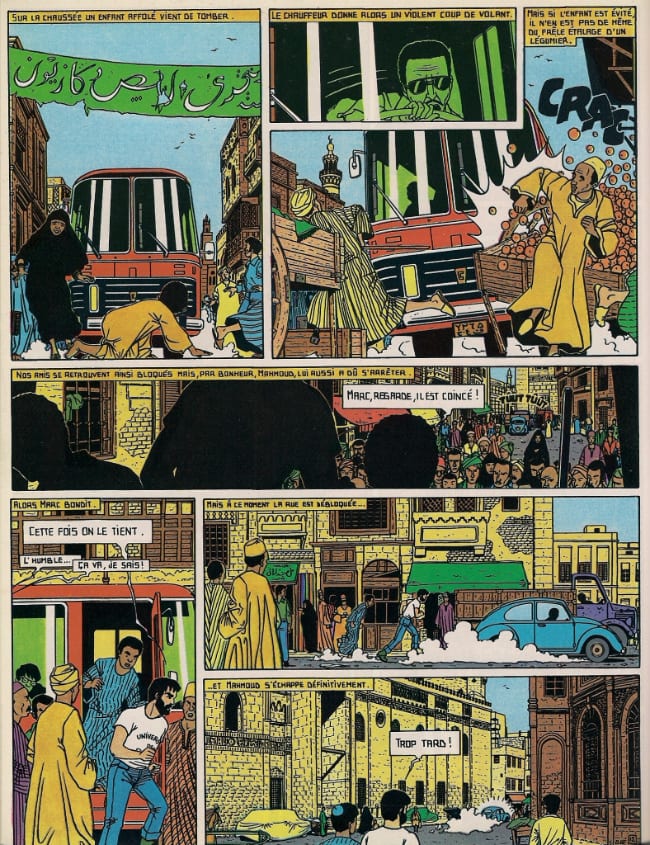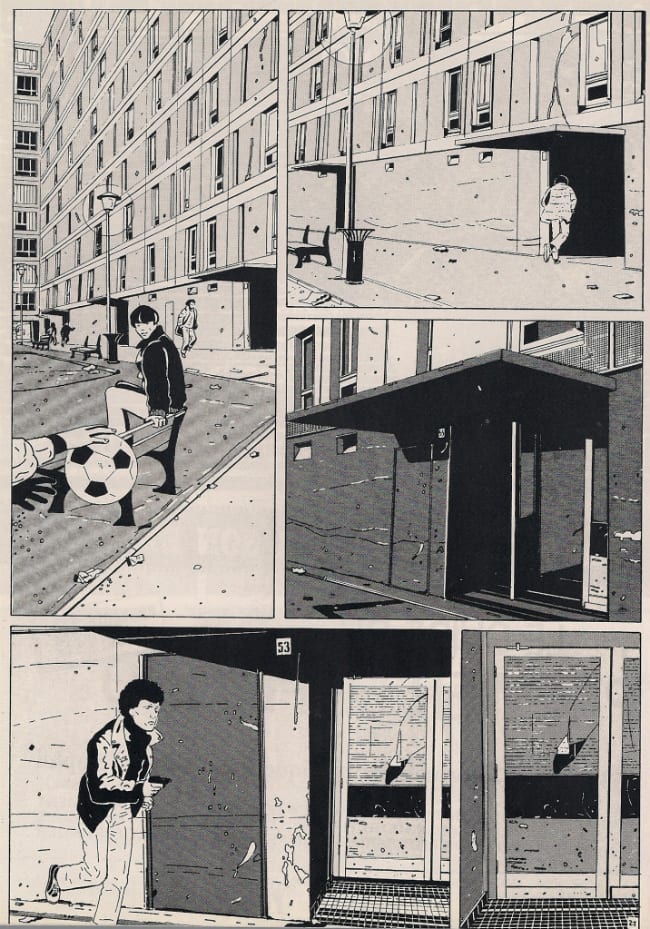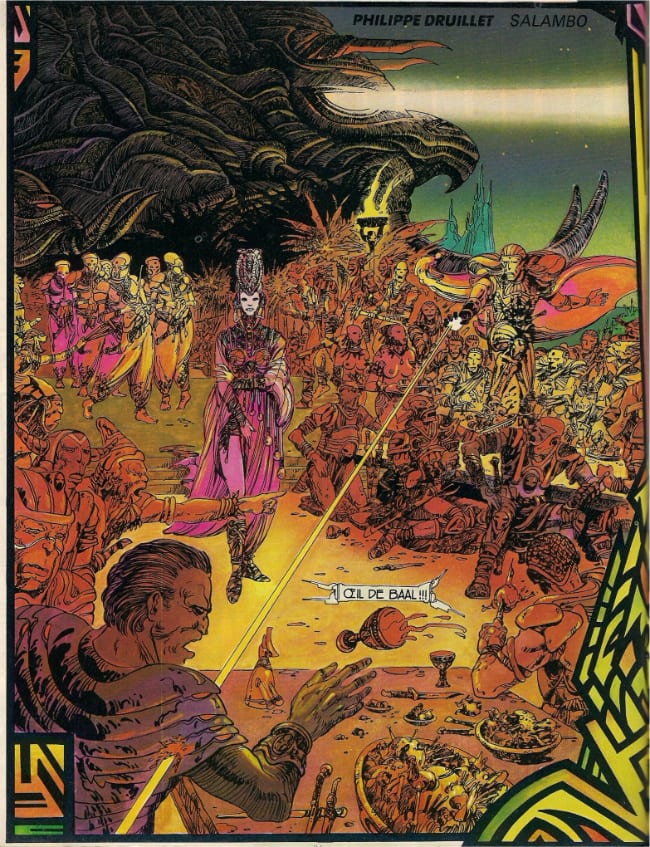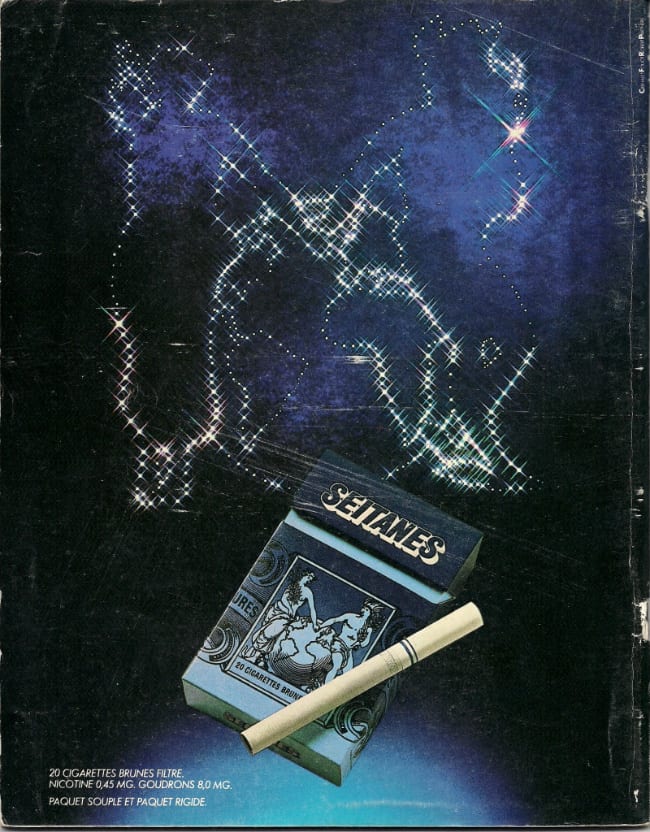One of the perks of a day job that requires travel is that I sometimes get time off in an unfamiliar place; because I am a creature of habit, and lucratively sad, I immediately attempt to impose some familiar order by looking up a local comic shop and paying a visit. My motto on these trips is that even the least promising retailer was perhaps seized at one time by the need or hope or fancy to throw money down some interesting hole and hang on to whatever curiosity was coughed up until someone, somewhere, finally buys it. A narcissist to the end, I endeavor to be the finale to these uninspiring stories.
By which I mean: I found cool shit in a comic book store again!! This time it was especially awesome, because I'm not entirely sure if it was an official product on the shelves, or some personal project the retailer (or a predecessor) deigned to flip for resale. Nonetheless, I am now the proud owner of a softcover bound edition of Métal Hurlant issues #47-52, covering January through June of 1980.
Actually, it's only issues #48-52, as #47 had already gone missing by the time I hit the scene. I'm thinking the binding itself might have been an accessory to the crime, since it took roughly five seconds after I got the package home for issue #52 to likewise drop free of its confines, fully intact, cover and all. I accepted this as a sign that I should examine the issue in isolation, as a bellwether of its time. After all, Les Humanoïdes Associés had been publishing the magazine for half a decade by then, and its U.S. counterpart, Heavy Metal, had been active for two and a half years, long enough to begin to shake free of its French origins and pursue a number of new works from English-dominant talents wandering the blighted post-underground scene of the American late '70s. As a result, English readers tend to think of Métal Hurlant, the French stuff, in terms dictated by early Heavy Metal, which suggests the visual approaches of Les Humanoïdes founders Moebius and Druillet, or fellow practitioners of handsomely surreal fantasy and personalized mystery.
Yet this was not a fixed thing in June of 1980.
Here is Jean-Michel Nicollet's cover to issue #52, upon which a woman is cruelly interrupted in carving the final delicate embroideries onto her bodypaint ensemble by a steampunk condor, possibly to inform her she's double-parked her tank. Fucking concert security! The logo in the upper left had been introduced in the issue prior as the magazine's second-ever fixed title design; it would last until January of 1982, at which point a variation on the old, blockier logo visible two pics above would be reinstated, and the band of text down the left side would be eliminated entirely. For now, it promises peeks into the bars and cocktails of Paris, and a look at famous bathtubs, along with several comics features introduced in the alternating smaller font. It's not just funnies in here - it's culture.
Nonetheless, the first BD feature front-loads the issue handily by presenting the great Hugo Pratt via a segment of his Fort Wheeling, a color sequel to a strip the artist had created in Argentina in the '60s. It's a tale of soldiers in the American colonies, a setting not entirely unlike that of Indian Summer, which Pratt would begin with artist Milo Manara in a few years.
Yeah, I'm a man of simple pleasures. A burning torch to the face, an exploding covered wagon, SOCK! and "HOUCH!" in the same panel - and god, that third frame on page two, where it's just gobs of black but you can not only make out what's happening but there's suspense in the dude creeping up behind him, coming into view with his arms raised to swing in panel four... that's all I need!
But artists of Pratt's longstanding renown would provide a sort of bookending force for issue #52, a magic circle of prestige surrounding a different development in comics art. We can catch an early hint in one of the magazine's text features, the MAGAZINE roundup of cool-looking movies, books, albums and comics, identified for your pleasure by the Métal Hurlant contributors.
Yves Chaland is behind many of the capsules on this page; he had been publishing with Les Humanoïdes for two years, and would soon be collaborating with Moebius as colorist on The Incal, which would begin serialization in issue #58. Turn your attention, however, to the first full paragraph in the third column, where Chaland comments on Défi de l'invisible, a 1963 installment of writer/artist Michel "Greg" Regnier's Rock Derby adventure series; the publisher is Magic Strip, a Belgian outfit which specialized at the time in reprinting classic mid-century comics albums. Chaland too was a great admirer of the old Belgian look, particularly the Marcinelle school of cartooning established by Joseph "Jijé" Gillain and mastered by André Franquin, an animated counterpoint to the Brussels school of Hergé and the "clear line" style, isolated and continued by the Dutch artist Joost Swarte in the '70s.
By 1981, Chaland and like-minded young artists would be reviving and modifying the mid-century aesthetic at Magic Strip under the publisher's Atomium 58 line of new albums, establishing the Atom Style as a movement in international comics, an evocation of post-WWII Belgian cartoon aesthetics in an often politicized, self-aware and ironic form.
As a result, either by way of editorial precognition or just happening to be the handiest forum around, this June of 1980 issue of Métal Hurlant is absolutely goddamned lousy with sprightly cartoon figures and handsome architectural flights. It's not a total departure from the mid-'70s genre avant-garde on which Les Humanoïdes was founded -- Moebius was a Jijé protégé, after all -- but it certainly stands in abject contrast to the enduring image of what proper French Heavy Metal art should look like; not just the covers that had shifted as the decade turned.
Chaland also had a comic in issue #52, the first part of his Bob Fish, which helpfully acknowledges the homage inherent to the nascent Atom approach in having a character examine his favorite comics on-page. With Magic Strip in '81, Chaland would launch his Freddy Lombard series of throwback comedic adventures with The Will of Godfrey of Bouillon, a near-automatic drawing exercise in which he completed one full page of a sprawling present-meets-past story per day until the album seemed done, allowing his sense of how old-timey comics 'worked' to guide him instinctively. He would continue to switch up his approach in subsequent projects, nonetheless orbiting a core, polished, vintage cartoon look until his untimely death in 1990.
Other artists weren't so visually constant. Here we see a jewel-like early page from Swiss artist Daniel Ceppi, who had begun self-publishing his comics only three years prior. Métal Hurlant was clearly excited by the young talent, as this story is the "CEPPI EN COULEURS" from the cover. Along with formatting changes, issue #51 had also brought a massive investment in color pages for the magazine, which had previously relied on Warren magazine-like insert sections for its 32-out-of-100 color ratio; by issue #52 color was all over the place (and the cover price had increased), allowing for a particular luster that perhaps aided the simplified forms of art like Ceppi's, reminiscent of Harold Gray in its dotted faces and delicate human figures. Check that link a ways back, though, to witness how the artist's style evolved into a more traditionally 'realist' look as he moved into longer series.
Likewise, Dominique Hé, a Moebius student, would eventually zoom in his perspectives to accommodate a more detailed view of his blocky characters. I can't comment on the motives or impulses behind each of these developing artist's styles -- hell, I can barely even struggle through the captions with my crap French -- but it's undeniable that something was in the air to unify so many of these pages.
On the other hand, we've also got this little ditty from Serge Clerc, spotting blacks and working limited colors in a manner similar enough to Chaland in the same issue, but to an extent that the work seems a bit different from the more familiar type indicated by his cover to my dubious softcover omnibus way back up top, dated the same year. Clerc more than anyone would be responsible for exporting the Atom Style to English-speaking territories via his contributions to the UK's New Musical Express and Melody Maker, from where Escape artist Rian Hughes would hone his own graphic techniques and eventually return the look to Magic Strip for the 1987 album The Science Service, among the last of the Atomium 58 comics.
Of course, some of issue #52's evocations went in a different direction.
Behold the mighty Andy Gang, by the great Chantal Montellier. You might remember her from the reliably disquieting 1996 series and its yooneek lowculeyezayshun from early issues of Heavy Metal, and as much as I love the ligne claire and Franquin and all their descendants, for sheer gut-level impact I'll always go for ice-cold disaffect in genre stuff; just look at that barely-mobile head shot in the final panel, like the guy's less rocked by the hammer-blow of a pistol than stunned at the unraveling of his own face. I've yet to locate so much as one interview conducted with Montellier in English -- she's perfectly accessible in French, mind you -- but I've read enough about her to make an educated guess that sapping the thrill-power from crime comics action is all part of the concept with Andy Gang, which runs like a Jacques Tardi comic from Earth-2, airless and schematic and acidly funny and entirely devoid of hope or trust in its depiction of lawmen that cause the real crime in society; his despite arriving before most of Tardi's actual detective comics!
It's not unreasonable here, I think, to read some criticism into the action comic proclivities of Métal Hurlant, or indeed its frequently boyish parade of naked ladies lolling inscrutably; Montellier serves up just as much nudity in Andy Gang, but only in the context of desecrated corpses. The series -- and the content in issue #52 is specifically from the storyline Andy Gang et le tueur de la Marne -- actually originated in one of the prime undiscovered Eurocomics terrains, Les Humanoïdes' second comics magazine, 1976-78's Ah! Nana, a women-driven anthology of satire and commentary that confronted issue-length topics like incest and BDSM and "Le sexe et les petites filles," and folded after nine issues when it found itself restricted to adult sales and thereby blocked from access to about 1/3 of its retail venues. Montellier commemorated the occasion by drawing the censors as the authoritarian cast of Andy Gang, which eventually ran to three collected albums, all of which appear to be out of print in France. Perhaps a concerned publisher can sweep in to rescue it, or at least translate the artist's 2003 Vertige Graphic collection Social fiction, compiling three classic Les Humanoïdes series, including 1996.
There's plenty of other stuff in Métal Hurlant #52, including work from French humor comics lifer Frank Margerin, but I owe it to you to showcase the only other comic mentioned on the cover, "LA 1ere BD POLAROID," a little ditty called Une lettre inutile from the artist Irutchka -- about whom I know absolutely nothing -- and a writer credited as "OX 174." It's an attempt at reviving fumetti in a more self-evidently low-fi, visual design-y manner, and it's astonishing in how closely it anticipates how artists like Dave McKean would reconfigure the look of certain "mature" American comic books later in the decade. If the Atom artists and Montellier evoked other styles as a means of homage and criticism, this is a little indication that the magazine could still predict a bit of the comics future, if mainly in keeping tabs on developments in the wider arena of visual arts.
And then, finally:
Motherfucking Philippe Druillet, aka the Les Humanoïdes founder that was a cartoonist and was not Moebius. There's a duality between them: Giraud, the timeless visionary and mystic chameleon, and Druillet, the most 1970s comics artist in all the history of humankind. He's still at it, though, having just released a new Lone Sloane album, Delirius 2, early last month. His contribution to this magazine was a chapter from Salammbô, an endeavor he'd be working on until 1986, reimagining Gustave Flaubert's 1862 historical novel as the 1st through 192nd-greatest prog rock album covers of all time. Or at least that was the effect, continuing into earnest fury onto the inside-back cover like an incantation to reestablish the historical period of all preceding words and pictures. Wrapping it up.
Even the back cover's ad seems apropos:
Ah, la cigarette! Something about this image makes me want to throw on Time Out of Mind and pretend I'm a rueful libertine, which is more than I can say for the house ads clogging up our comics today. So here's to you, Métal Hurlant: you truly were perfection and grace, and the smile on my face, even after our modern history forgot what you became.
***
PLEASE NOTE: What follows is not a series of capsule reviews but an annotated selection of items listed by Diamond Comic Distributors for release to comic book retailers in North America on the particular Wednesday, or, in the event of a holiday or occurrence necessitating the close of UPS in a manner that would impact deliveries, Thursday, identified in the column title above. Not every listed item will necessarily arrive at every comic book retailer, in that some items may be delayed and ordered quantities will vary. I have in all likelihood not read any of the comics listed below, in that they are not yet released as of the writing of this column, nor will I necessarily read or purchase every item identified; THIS WEEK IN COMICS! reflects only what I find to be potentially interesting.
***
SPOTLIGHT PICKS!
King City: Being Image's long-awaited 424-page all-in-one edition of Brandon Graham's 2007-10 sci-fi series, a conversational cut of fanciful of world-building initially released in part by now-hibernated manga specialist Tokyopop -- though I felt its no-rush, detail-oriented storytelling also evoked a certain kind of early '80s imaginative density, like Time2 or Starstruck -- then split into large-format comic books released in association with Image. Those comic book chapters got tricky to find early on, so this compilation -- oversized like the comics, and set to include all of the bonus features from the individual issues -- should supersede as the preferred edition. The internet remains dense with a bounty of samples; $19.99.
Friends with Boys: A 224-page First Second compilation of a webcomic by cartoonist and animator Faith Erin Hicks -- although actually I think it was always intended for print, and became a webcomic in partnership with the publisher -- concerning a homeschooled girl adapting to public school life and encountering some supernatural stuff. First Second has come to specialize in a high-end brand of YA-aimed mainstream comic, and this is one of their more prominent releases of late. Samples (lots of 'em until later this week, then fewer); $15.99.
--
PLUS!
Blue: A new Top Shelf release of work by Australian cartoonist Pat Grant, a slice-of-life piece about teenage antics and the (one presumes) metaphorical tentacled alien presence in society. Really, this has all been efficiently laid out by the artist, and I should say nothing more. Two colors, 96 pages, 9.4" x 6.6" in landscape format. Online in its entirety here; $14.95.
The Compleat Terminal City: Paul Gravett has suggested that Dean Motter's '80s sci-fi series Mister X also functions as an English-language appendage of the Atom Style, particularly through the visual concepts of Paul Rivoche, though readers of this site will doubtlessly remember it better as a forum for early work by the Hernandez Brothers and Seth. This is a 368-page Dark Horse edition of a subsequent Motter-written retro futurism project, a pair of 1996-98 Vertigo series blending noir and robots and stuff, drawn by Michael Lark. Samples; $24.99.
Hellboy Vol. 12: The Storm and the Fury: The last big collection of artist Duncan Fegredo's excellent tenure as primary artist on Mike Mignola's signature series, and a handy reminder of how world-shattering climactic action man sturm und drang can work marvelously as visceral entertainment, even while mostly existing to set up yet further plot developments (particularly the return of Mignola as writer/artist). Probably not a great choice for your first Hellboy comic, but if you've been wondering if the kind of genre licks that power the continuing superhero comic book industry can succeed apart from the windows-onto-a-virtual-world focusing effect that dominate high-profile crossover events, the answer for me was yes - in fact, the comparative lack of baggage makes 'em register much clearer. Preview; $19.99.
Avengers: 1959: Also in superhero comics set a little bit apart comes a softcover collection for Howard Chaykin's most recent solo project, a period espionage thriller dotted with various Marvel characters bent to Chaykin's particular purposes, including the artist's own Dominic Fortune. An Image-published sequel to Black Kiss is next in line; $16.99.
EmiTown Vol. 2: Speaking of Image (again), here's a second 400-page volume of autobiographical comics by prolific Emi Lenox, coming just over a year after the first; $24.99.
No Longer Human Vol. 3 (of 3): Wrapping up Vertical's recent push of releases by Usamaru Furuya, a hard-to-keep-tabs-on talent here adapting novelist Osamu Dazai's 1948 landmark in a modernized setting; $10.95.
Chi's Sweet Home Vol. 8: Likewise, this 160-page cut of color cat manga by Kanata Konami brings Vertical's releases nearly up to speed with the Japanese series, which saw its ninth volume released this past December; $13.95.
One Piece Color Walk Vol. 2: We may never have a long wait for more of Eiichiro Oda's widely-liked, zillion-selling megahit, but while Viz indeed has vol. 61 of the collected editions ready to fly (it's up to 65 in Japan), I'll turn some attention to this anticipated sophomore release of color images by the artist, 110 pages at 11.5" x 8.2", with an interview included; $19.99.
Lynda Barry: Girlhood through the Looking Glass: Finally, your book-on-comics of the week, a 208 University Press of Mississippi release by Susan E. Kirtley, who "concentrates on Barry's recurring focus on figures of young girls, in a variety of mediums and genres," per the publisher. "In tracing Barry's aesthetic and intellectual development, Kirtley reveals Barry's work to be groundbreaking in its understanding of femininity and feminism." Probably worth a look; $25.00 ($65.00 in hardback).
--
SPECIAL BONUS SECTION: Eh, Diamond doesn't have any conflicts of interest ready for Wednesday, but this post still seems awfully unbalanced.
Thus, in commemoration of the one-and-a-half minute anniversary of your having read the first half of this post, here is a French bartender:
And here's Serge Gainsbourg sitting in his famous bathtub:
We remain, as always, your full-service comics column.




